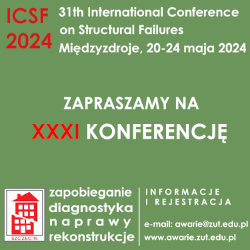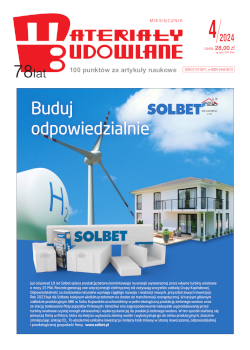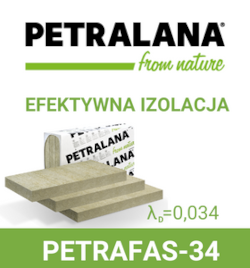Open Access (Artykuł w pliku PDF)
Open Access (Article in English PDF file)
Consideration of foundation stiffness in the design of slender reinforced concrete columns in single-story frame structures
dr inż. Krzysztof Klempka, Uniwersytet Warmińsko-Mazurski w Olsztynie, Wydział Geoinżynierii
ORCID: 0000-0002-5144-6681
dr inż. Ireneusz Dyka, Uniwersytet Warmińsko-Mazurski w Olsztynie, Wydział Geoinżynierii
ORCID: 0000-0002-0996-264X
Adres do korespondencji: Ten adres pocztowy jest chroniony przed spamowaniem. Aby go zobaczyć, konieczne jest włączenie w przeglądarce obsługi JavaScript.
DOI: 10.15199/33.2024.02.03
Oryginalny artykuł naukowy
Streszczenie. W projektowaniu konstrukcji parterowych hal istotne jest uwględnienie sztywności posadowienia, która wpływa na wartość momentów zginających w słupach. W artykule przedstawiono metodę i przykłady obliczeń drugiego rzędu uwzględniające wpływ sztywności podpory na rozkład momentów zginających w słupach wspartych na stopach oraz palach fundamentowych. Przedstawiona metoda pozwala na bardziej precyzyjne, bezpieczne i optymalne projektowanie smukłych słupów żelbetowych.
Słowa kluczowe: smukły słup żelbetowy; efekty drugiego rzędu; sztywność posadowienia; fundament palowy.
Abstract. In the design of single-story frame structures, it is important to consider the foundation stiffness, which affects the value of bending moments in columns. The article presents a method and examples of second-order calculations that take into account the effect of support stiffness on the distribution of bending moments in columns supported on footings and foundation piles. The presented method allows more precise, safe and optimal design of slender reinforced concrete columns.
Keywords: slender reinforced concrete column; second-order effects; foundation stiffness; pile foundation.
Literatura
[1] Eurocode 2: Design of Concrete Structures. Part 1-1. General Rules and Rules for Buildings. EN 1992-1-1:2008.
[2] Klempka K, Knauff M. Design of slender RC columns according to Eurocode and polish code compared with the improved numerical model.Archives of Civil Engineering, 2005; 1.
[3] Pędziwiatr J, Musiał M. Calculation of second- -order effects in columns – applications and examples. Archives of Civil Engineering, 2023; DOI: 10.24425/ace. 2023.144173.
[4] Hamed E, Lai C. Geometrically and materially nonlinear creep behaviour of reinforced concrete columns. Structures. 2016; 5, 1 – 12.
[5] Gilbert RI, Ranzi G. In-service deformations of reinforced concrete columns in biaxial bending. Proceedings of the Twelfth EastAsia-Pacific Conference on Structural Engineering and Construction,Hong Kong, China, 26–28 January 2011, pp. 410-418.
[6] Kim CS, Gong Y, Zhang X, Hwang HJ. Experimental study on long-term behavior of RC columns subjected to sustained eccentric load. Adv. Concr. Constr. 2020; 9, 289–299.
[7] Knauff M. Obliczanie konstrukcji żelbetowych wg Eurokodu 2, Wydawnictwo Naukowe PWN, 2012.
[8] Knauff M, Klempka K. Effective lengths of reinforced concrete columns in single-storey frame structures in the light of the Eurocode. Technical Sciences No 12, str. 71-82, 2009.
[9] Knauff M, Klempka K. Projektowanie smukłych słupów żelbetowych według Eurokodu 2. Inżynieria i Budownictwo. 2009; 12: 663 – 665.
[10] Gorbunow-Posadow MT. Obliczanie konstrukcji na podłożu sprężystym. Budownictwo i Architektura, Warszawa 1956.
[11] Lewiński P. Analiza współpracy żelbetowych zbiorników cylindrycznych z podłożem. ITB, Warszawa 2007.
[12] Coyle HM, Reese LC. Load transfer for axially loaded piles in clay. J. Soil Mech. Found. Div. 1966, 92: 1 – 26.
[13] VijayvergiyaVN, Focht JA. Anew way to predict the capacity of piles in clay. Proceeding of the 4-th Annual Offshore Technology Conference, Houston, TX, USA, 2-5 May 1977.
[14] Randolph MF, Wroth CP. Analysis of deformation of vertically loaded piles. J. Geotech. Eng. Div. 1978, 104: 1465 – 1488.
[15] Kraft LM, Ray RP, Kagawa T. Theoretical t-z curves. J. Geotech. Eng. Div. 1981, 107: 1543 – 1561.
[16] Guo WD, Randolph MF. Rationality of load transfer approach for pile analysis. Computers and Geotechnics. 1998; 23: 85 – 112.
[17] Zhu H, Chang MF. Load transfer curves along bored piles considering modulus degradation. J. Geotech. Geoenviron. Eng. 2002; 128 (9): 764–774.
[18] Lu Q, Luo Q. A Load Transfer Approach for Studying the Load-Deformation Response of Vertically Loaded Single Pile. Proceedings of the 2nd International Symposium onAsia Urban GeoEngineering, 2018; Springer Series in Geomechanics and Geoengineering, pp. 369-384, https://doi. org/10.1007/978-981-10-6632-0_29.
[19] Bateman AH, Crispin JJ, Vardanega PJ, MylonakisGE. Theoretical t -z Curves forAxially Loaded Piles. J. Geotech. Geoenviron. Eng. 2022, 148, 04022052.
[20] Dyka I. Analiza i metoda obliczeń osiadania grupy pali. Praca doktorska, Politechnika Gdańska, czerwiec 2001.
[21] Randolph MF. Science and empiricism in pile foundation design. Geotechnique, 2003; 53(10): 847 – 875.
[22] Poulos HG. Pile Group Settlement Estimation – Research to Practice. Foundation Analysis and Design: Innovative Methods (GSP 153). Proceedings of Sessions of GeoShanghai 2006.
[23] Mandolini A, Russo G, Viggiani C. Pile foundations: Experimental investigations, analysis and design. Proc. of 16th international Conference of Soil Mechanics & Geotechnical Engineering, Osaka, Japan, 12-16 September 2005.
[24] Chow YK. Analysis of Vertically Loaded Pile Groups. International Journal for Numerical andAnalyticalMethods in Geomechanics. 1986; Vol. 10, pp. 59 – 72.
[25] Dyka I. Use of the laboratory tests of soil modulus in modelling pile behaviour. Studia Geotechnica et Mechanica, 2012, Vol. XXXIV, No. 3 (2012).
[26] Srokosz P, Dyka I, Bujko M. Interpretation of shear modulus degradation tests. Studia Geotechnica et Mechanica. 2018; Vol. XXXX, No. 2 (2018), str. 125-132, DOI: 10.2478/sgem-2018-0015.
[27] Fahey M, Carter JP. A finite element study of the pressuremeter test in sand using nonlinear elastic plastic model. Canadian Geotechnical Journal. 1993; 30: 348–362.
[28] Van ImpeWF, De Clercq Y. A Piled Raft InteractionModel. Proc. of 5-th International Conference and Exhibition on Piling and Deep Foundations – DFI’94, Bruges, Belgium, 13-15 June 1994.
[29] Bustamante M, Gianaselli L. Pile bearing capacity prediction by means of static penetrometer CPT. Proceedings of 2nd European Symposium on Penetration Testing, ESOPT – II, Amsterdam, 1982.
[30] Mayne PW, Rix G. J. Gmax-qc relationships for clays. Geotechnical Testing Journal. 1993; 16 (1): 54 – 60.
[31] Gwizdała K, Stęczniewski M, Dyka I. Wykorzystanie sondowań statycznych do obliczeń nośności i osiadań pali. Materiały seminarium „Fundamenty palowe 2009”. NOT Warszawa, 22 kwietnia 2009 r.
Przyjęto do druku: 18.01.2024 r.
Materiały Budowlane 2/2024, strona 11-16 (spis treści >>)




























